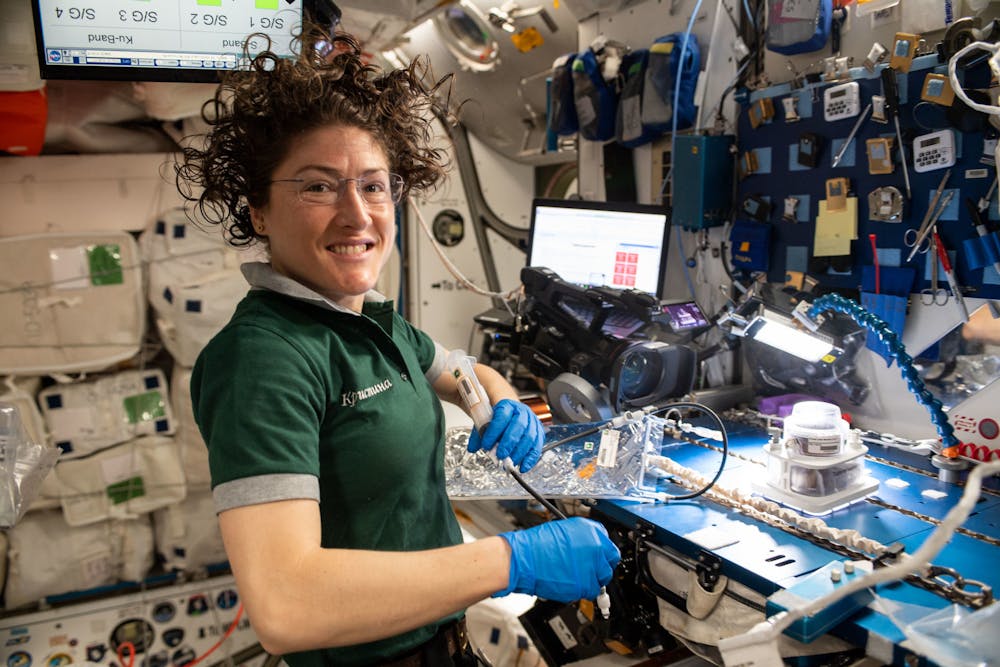On Friday, Dec. 1, the Johns Hopkins University Applied Physics Laboratory (APL) hosted a colloquium presentation featuring astronaut Christina Koch. The talk, titled “Human Spaceflight: A Mission to the International Space Station,” discussed Koch’s journey to becoming an astronaut and life in space.
Koch’s career began at NASA’s Goddard Space Flight Center, where she developed high-precision science instruments for space missions. Despite words of caution from her colleagues, she left this position to work at the South Pole as part of the U.S. Antarctic Program.
“I am someone who loves the idea of science and exploration on the frontiers. When I was a kid, I had posters of space in my room, but also maps of Antarctica,” Koch explained.
A year later, Koch returned to the APL, where she continued her work on remote sensing instruments. She helped to develop the Jupiter Energetic Particle Detector Instrument (JEDI), which coordinates several instruments on the helm of the Juno spacecraft to understand the generation of auroras on Jupiter.
The Juno mission would play a pivotal role in Koch’s journey to becoming an astronaut. In 2009, during Koch’s employment at APL, NASA released a call for astronauts. Though she mulled over the opportunity, Koch decided not to apply.
“I said no because of [the Juno mission]. I knew that until I saw [Juno’s launch], this dream come true, that I hadn’t done enough here to be able to tell someone in human spaceflight, ‘Hey, I think I’ve gathered what I need to contribute to your team,‘“ Koch explained.
Koch’s exploratory spirit took her to Greenland to continue investigating the arctic frontier; however, she would return to Cape Canaveral, Fla. to witness the 2011 Juno launch.
“At that moment, I thought my closest dreams to going to space were completely fulfilled… To me, the most important thing was contributing to this field of space science. That feeling was one of the most awesome feelings I’ve ever had.”
With her dream fulfilled, Koch set her mind toward her childhood ambitions. In 2013, she was selected to be an astronaut alongside seven others as part of Astronaut Group 21. Koch claimed that the most important component of her selection process wasn’t her academic or professional successes but rather her personal ventures. While an employee of APL, Koch had regularly joined her colleagues in outdoor activities, including sailing and ‘trad’ climbing — rock climbing without pre-placed safety equipment.
“People wanted to know. Have you ever been scared? Have you ever worked on a team? Have you ever pushed yourself in a physical environment while you’re undergoing a lot of other mental stress and been successful? These experiences I had with people here in Maryland are what allowed me to talk about examples,” she said.
Over the next six years, Koch underwent the grueling astronaut training process. The first two years of classroom-based training are called the ‘astronaut training candidate period.’ Another former APL employee, Andre Douglas, is currently in this stage.
In the next phase, which Koch termed the “learn five new careers in two years” phase, astronaut trainees learn hands-on skills relevant to spaceflight. This includes learning to fly a jet, spacewalk in neutral buoyancy conditions, operating systems aboard the space station and speaking Russian. Finally, astronauts are assigned to a flight mission and undergo two more years of flight-specific training before going to space.
Koch then recounted her time in space as she narrated a video documenting her journey to the International Space Station (ISS). Koch launched to the ISS aboard the Russian-built Soyuz Rocket, which took over the role of transporting astronauts to the ISS after the retirement of the American Space Shuttle program in 2011.
“No kidding, we get in this old, krinkety [sic] elevator, and you get to the top, and you just climb in. It’s like every simulation you’ve ever been in, but real,” Koch explained as the launch played behind her. “The rocket fires, and you just start moving. You go up, and up, and up, and up. You go up for eight minutes straight. At the end of all that going up, there’s only one place you can be. Space. That’s exactly where you are.”
According to Koch, the ‘real purpose’ of space missions is to conduct scientific experiments. The microgravity of space is especially alluring to scientists as it uncovers phenomena that are usually hidden by the dominant gravitational effects on Earth. Aboard the ISS, Koch assisted with space technology development through gardening, creating cell/tissue models of human systems and conducting particle physics experiments.
Koch would remain in space for 328 days, setting the record for the longest single-stay in space for a woman, previously held by astronaut Peggy Whitson's 289 days. While in space, Koch was quick to downplay this impressive achievement due to her modest view of her mission; however, an email from her mentor prompted her to reconsider this viewpoint.
“[He said,] ‘Don’t forget, milestones are important to people. What you’re doing is important to a lot of people,’” Koch recounted. “I realized that milestones help the public know what we’re doing, what state of the art is in space exploration and what it means to push the boundaries.”
Koch hopes to continue to push boundaries as a member of the 2024 Artemis II mission, where she will become the first woman to travel to the moon. For ten days, Koch and three crewmates will slingshot around the moon before returning to Earth aboard NASA’s Orion spacecraft. The data collected in this mission will be the first step toward establishing a long-term lunar base.
In a recent tweet, Koch said, “We are going.” In other words, we are just beginning our journey into deep space exploration and are far from stopping.





